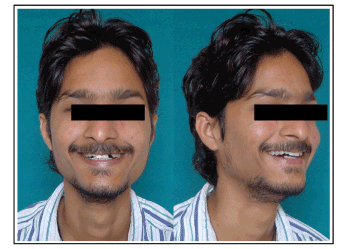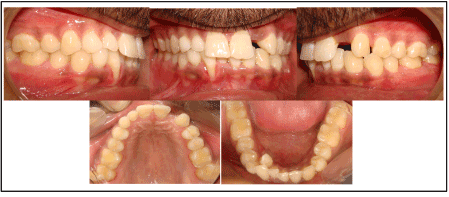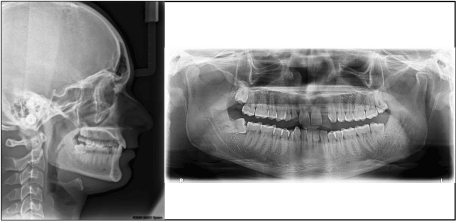
Figure 1: Extra Oral Photos

Rohit Kulshrestha*
Saraswati Dental College, Faizabad Road, Lucknow, Uttar Pradesh, India*Corresponding author: Rohit Kulshrestha, Saraswati Dental College, PG Boys Hostel, Faizabad Road, Lucknow, Uttar Pradesh, India, Tel: +918601462462; E-mail: kulrohit@gmail.com
This article is a retrospective study along with a case report, which examined the occurrence of missing and impacted permanent teeth in patients of Saraswati Dental College Lucknow over a period of one year. A total of 300 (165 male, 135 female) consecutive patients who presented for treatment in the Department of Orthodontics and Dentofacial Orthopedics were considered for this research; 37 cases had either missing or impacted teeth out of which 19 cases presented with one to two congenitally missing teeth, 2 of the cases had three to five missing teeth and 18 presented with one or more impacted teeth. No case was seen with both congenitally missing and impacted teeth. The case analyses focused on the type and number of missing or impacted teeth. The following teeth were most frequently missing: mandibular 3rd molars (2%), maxillary 3rd molars (1.3%), mandibular incisors (1.3%), maxillary laterals (1%), maxillary premolars (0.33%), mandibular premolars (0.33%). In the maxillary arch there were 15 cases of impacted canines (5%) of which 2 cases were bilaterally impacted maxillary canines (0.66%). Only one case presented with missing maxillary canine. In the mandibular arch there were 2 cases of unilateral mandibular impacted canines (0.66%). There was only one case with an impacted mandibular central incisor. The high prevalence, severe degree of dental agenesis and impaction of permanent teeth found in these patients reflects an interdisciplinary treatment need for these patients.
Missing teeth; Impacted teeth; Hypodontia
Hypodontia is defined as the developmental absence of one or more teeth either in the primary or permanent teeth excluding third molars. Patients with hypodontia, especially developmentally missing anteriors with spacing incisors may present in varying degrees of severity prompting them to seek treatment for improvement in dentofacial aesthetics and function [1]. The prevalence of hypodontia in the primary dentition is about 0.5% and ranges from 3.5-6.5% in the permanent dentition of Caucasians, with females outnumbering males by a ratio of 3:2 [2]. Polder et al. [3] on meta analysis found that the prevalence of missing permanent teeth varies from 2.2% to 10.1%, excluding third molars, which are absent in around 20% of individuals. However, mandibular incisors were found to be the most commonly absent teeth in Chinese and Japanese populations and was more prevalent than missing maxillary lateral incisors [2]. Similar findings have been reported in local Malaysian children where the prevalence of missing mandibular incisors was the highest among developmentally missing teeth (32-49%) [2]. The prevalence of hypodontia was 7.54% (8.09% female and 6.54% male) in the Turkish population [4]. Hypodontia was found considerably more frequently in the maxilla than in the mandible [5]. The meta analysis conducted by Polder et al. [3] revealed that the teeth most commonly affected are the mandibular second premolars (41%), maxillary lateral incisors (23%), maxillary second premolars (21%). Missing maxillary central incisors and canines was rare and was only seen in very severe cases of hypodontia [6]. Patients commonly complain of gaps between their front teeth. Hypodontia usually has a genetic basis and often a high proportion of affected individuals have a family history of hypodontia or associated dental anomalies. Mutation in transcription factors MSX1, PAX9 and AXIN2 have been identified in families with an autosomal dominant oligodontia [3,4]. The aim of the current research was to investigate the occurrence of missing and impacted permanent teeth in orthodontic patients which reported to the Department of Orthodontics and Dentofacial Orthopedics Saraswati Dental College Lucknow.
This study was approved by the Regional Ethical Committee on Research of Saraswati Dental College, Hospital and Research Centre Lucknow. Before participation in the study, written informed consents were obtained from the patients. The study is a retrospective case series analysis of 300 consecutive patients (165 male, 135 female) who presented for orthodontic treatment at Saraswati Dental College Lucknow in the past year. The primary data consisted of the patient’s medical and dental history, photographs (intra oral and extra oral), gypsum models of the maxilla and mandible, and a dental pantomograph. The analyses were focused on the type and number of missing teeth and unilateral versus bilateral agenesis.
Presenting here is a case report of patient number 114 who came for orthodontic consultation. The 22 year old male patient reported to the Department of Orthodontics Saraswati Dental College Lucknow, complaining of poor dental aesthetics. Gaps were present in the upper front teeth and irregularly placed lower front teeth (Figures 1 and 2). He had no history of trauma or hospitalization. His parents and 4 brothers all had a full compliment set of teeth. He had no history of any drug intake while growing up or any X-ray radiation exposure. Clinically he had missing maxillary lateral incisors, missing right maxillary canine and over retained 52,53. His upper left maxillary canine is present. In the mandible he had over retained 83 and a lingually blocked out 43. 6 mm gingival recession in relation with 42 is seen. On OPG examination 12,13 and 22 are missing (Figure 3) . He has a deficient maxilla with a skeletal class I base and Angles class I malocclusion. His maxillary and mandibular anteriors are retroclined as the inter incisal angle is 142 degrees, crowding is present in the mandibular anterior region. The treatment plan of extracting all the decidous teeth including the periodontally compromised 42, with implant prosthesis for missing teeth after orthodontic alignment phase was accepted by the patient.

Figure 1: Extra Oral Photos

Figure 2: Intra Oral Photos

Figure 3: Lateral Cephalogram and OPG
The final data set comprised 300 patients. The following teeth were most frequently missing: mandibular 3rd molars (2%), maxillary 3rd molars (1.3%), mandibular incisors (1.3%), maxillary laterals (1%), maxillary premolars (0.33%), mandibular premolars (0.33%). In the maxillary arch there were 15 cases of impacted canines (5%) of which 2 cases were of bilaterally impacted maxillary canines (0.66%). Only one case presented with a missing maxillary canine. In the mandibular arch there were 2 cases of unilateral mandibular impacted canines (0.66%). There was only one case with impacted mandibular central incisor. No case reported missing maxillary central incisor. Missing maxillary lateral incisors were seen in 3 cases of which 2 cases showed bilaterally missing laterals and one case showed only one missing lateral incisor. Cases with peg shaped lateral incisors were also seen and they have been excluded from the study as they do not count as missing or impacted teeth. 1 case of unilateral missing canine was seen in the maxillary arch. Missing maxillary premolar was seen only in one case. Missing maxillary 3rd molars were seen in 4 cases. In the mandibular arch there were 4 cases of missing mandibular incisors. 1 case of impacted mandibular central incisors was seen. No cases of missing mandibular canines were seen. Unilateral impacted mandibular canine was seen in 2 cases. Missing mandibular premolar was seen in 1 case. 6 cases of missing mandibular 3rd molar were seen. Medical syndromes were diagnosed in none of the patients.
Missing permanent teeth were found in 19 (6.3%) of the 300 patients. Among these, 1 case (0.3%) had one or two missing teeth, three to five teeth were absent in 1 case (0.3%). Severe degree of absence (four to six or greater than or equal to seven missing teeth) was not seen.
Impacted teeth were found in 18 (6%) of the 300 patients. Among these 15 cases of impacted canines were seen in the maxillary arch or which 2 were bilaterally impacted. One case of impacted mandibular central incisors was seen. 2 cases of unilateral impacted mandibular canines were also seen.
The data for this retrospective study was based on residents of Lucknow seeking orthodontic treatment. No data is available that represents the dental status of the entire adolescent population of Lucknow. All 300 patients were consecutive and the aim was to determine the need for multidisciplinary treatment due to missing and impacted permanent teeth. Therefore, no bias was expected in the group of patients. In this investigation of missing and impacted permanent teeth among orthodontic patients, it was found that the frequency of missing teeth was irregular so was the frequency of the impacted teeth. Population prevalence of dental agenesis reported in the literature typically range between 4 and 7 per cent [7-9]. The aetiology of dental agenesis is still not quite clear. Several hypotheses have been postulated. It has been demonstrated that genetic factors with a marked degree of penetrance plays a major role in dental agenesis [10].
The linkage of dental agenesis and human genes has been established. A mutation in human genes causes selective tooth agenesis [11]. The influence of hereditary and environmental factors on the reduction of tooth number in human dentitions is illustrated by the prevalence of 36.5% found in a genetic and religious isolated population in North America [12]. Developmental anomalies, endocrine disturbances, local factors as pathology, facial trauma and medical treatment have also been mentioned as etiological factors [3]. A developmental relationship between nerve, oral mucosa, supporting tissues and hard tissue has been proposed [3]. Although this sample of 300 was probably large enough to be conclusive, it consisted of orthodontic patients and therefore could not be regarded as representative for the population. The mandibular third molar is clearly the most frequently absent tooth, followed by the maxillary third molar and the mandibular incisors. In some studies a different sequence from most to least affected teeth is found [7]. Sample size or incomplete examination may explain this difference.
Agenesis of maxillary central incisors, maxillary and mandibular first molars and mandibular cuspids are very rare [3]. Whenever these teeth are missing, loss of teeth because of trauma, caries and extraction must be carefully excluded before the diagnosis of agenesis is confirmed. Most patients (83%) with dental agenesis have absence of one or two permanent teeth [3]. The absence of more than six missing permanent teeth is very rare (0.14%). For patients with oligodontia, defined as dental agenesis of six or more teeth, other factors than only prevalence are important (inheritance, reduction in size and form of teeth, reduction in size and shape of the alveolar process, combination with syndromes) [8]. The clinical significance of number and location of dental agenesis and the relation with size and shape abnormalities of the other teeth is still not fully clear. Most publications on treatment of dental agenesis are case-presentations. The data in the present study is based on patients presenting with dental agenesis at Saraswati Dental College, the figures are not comparable with population-based prevalence [12]. The reason for dental agenesis is unknown, but mutations of the genes PAX9 and MSX1, which are inherited in an autosomal dominant manner, have been suggested [10].
The prevalence of congenitally missing and impacted permanent teeth in the population of Lucknow was at par with studies in the other regions of the world. Multidisciplinary treatment facilities for patients with dental agenesis should, therefore, be available as it will benefit the patients in a large way [11]. There is a need for a population-based epidemiological study that would enable a determination of the occurrence and possible geographic variation of permanent missing and impacted teeth in this region.
Download Provisional PDF Here
Article Type: Case Report
Citation: Kulshrestha R (2015) Missing and Impacted Teeth in Orthodontic Patients of Lucknow Population: A Case Report. Int J Dent Oral Health 1(4): doi http://dx.doi.org/10.16966/2378-7090.123
Copyright: © 2015 Kulshrestha R. This is an open-access article distributed under the terms of the Creative Commons Attribution License, which permits unrestricted use, distribution, and reproduction in any medium, provided the original author and source are credited.
Publication history:
All Sci Forschen Journals are Open Access